PERGAMUM
CHURCH (RED COURT, SERAPYS TEMPLE)
Pergamum church is
one of the seven churchs. The people of Pergamum calls "Red Court". İts reason; when you look at outside, it is covered by red bricks.If
you look the photos carefully you cau can see a few marble between the red bricks. |
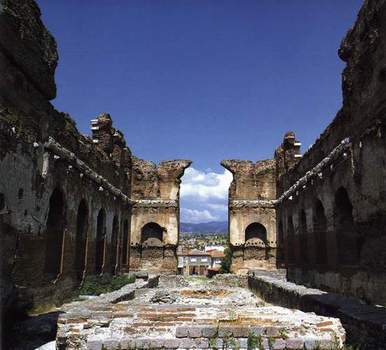 |
Pergamum was, at the time that the new religion travelled along the caravan routes of Asia
Minor or was carried by trade ships which brought olive oil from Cilicio or copper from
Cyprus to its port Eiaea, one of the largest cities of the region. Jts wealth, number of
temples and their beauty were eclipsed only by those of Ephesus. By the first century the
Hellenistic city on the acropolis was no longer large enough to accommodate the growing
population and the city began to spread to the voiley extending towards the Asclepion. The
history of Pergamum began after the death of Lysimochus, one of Alexander's generals. In
281 BCE when Lysimochus was killed in the bottle of Curupedion against the Seleucids,
Philetairos, governor of Pergamum, found himself in control of the city and owner of a
large treasury which he spent making the city stronger. Under a series of able and
energetic rulers, Pergamum become one of the most important powers of the area. Under
Eumenes II (197-159 BCE) the whole of western Asia Minor was acquired from Rome for his
help during the baffle of Magnesia against the Seleucids (190 BCE) Pergamum become the
sole kingdom of the region. |
|
The largest construction in Ancient Pergamon is the temple that was devoted to the
Egyptians' gods. It was built with red bricks and is called the red courtyard by the
people. It covers an area of 260*100 m. Along with the lalrge courtyard in front of th e
temple. It is a structure with basilika absids and 3 nephs. The temple opens up to a
courtyard through two constructions with towers. The pools inside the temple and the two
constructions show that there were another religion besides that of the Helens and the
Romans. It is believed that the Egyptians devoted it to the underground god serapis,
because the temple, which is decorated with Egyptian styled statues, is facing west. The
temple was erected in the time of the emperor Hadrian. The main structure was changed into
a church with changes made especially in the absid area. Then it was devoted to the
Apostel Johannes. Eumenes Ills remembered for the Great Altar that hebuilt on the
acropolis. This is one of the most important monuments of the Hellenistic period.
Aftalos ill who did not have a legitimate heir, probably
realized that the end of Pergamum was inevitable and in order to prevent war over the
succession, bequeathed his kingdom to Rome on his death in 133 BCE. The city continued to
grow under the patronship of its Roman rulers. Along with Ephesus, it was the earliest
city where the Roman imperial cult was established. As the seat of a Hellenistic kingdom,
people were familiar with the concept of ruler cult which was practised in the Hellenistic
heroön whose ruins have survived. The arrival of Rome gave new vigour to the city.
Skillful builders, they made terraces on vaults and erected new temples, baths and other
civic buildings. While the Attalids had used andesite, which was the local mountain stone,
new buildings were in marble. The ruins of the asclepion, stadium and amphitheatre are all
Roman. After those in Cos and Epidauros, the Asclepion of Pergamum was the most important
medical centre in the Roman Empire.
The citys prosperous history continued until the Arab
conquests in 663 and 71 6. Unable to revive thereafter its acropolis was used as a
Byzantine stronghold and then fell into oblivion. At left you can see a plan of Red Court which was referenced from
Fatih Cimok. |

|
To the church in Pergamum
To the angel of the
church in Pergarn urn, write this:
The one with the sharp two-edged sword says this: I know
that you live where Satan's throne is, and yet you hold fast to my name and have not
denied your faith in me, not even in the days of Antipas, my faithful witness, who was
martyred among you, where Satan lives. Yet I have a few things against you. You have some
people there who hold to the teaching of Balaam, who instructed Ba/ak to put a stumbling
block before the Israelites: to eat food sacrificed to idols and to play the harlot.
Likewise, you also have some people who hold to the teaching of (the) Nicolaitans.
Therefore, repent. Otherwise, I will come to you quickly and wage war against them with
the sword of my mouth.'
Whoever has ears ought to hear what the Spirit says to the
churches. To the victor I shall give some of the hidden manna; I shall also give a white
amulet upon which is inscribed a new name, which no one knows except the one who receives
it.
At the beginning of the letter to this church St John
introduces Christ as the one who has the two-edged sword. The allusion comes from the
letter to the Hebrews |
|
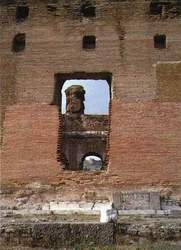 |
(Heb 4:12): Indeed, the word of God is living and effective, sharper than any two-edged
sword, penetrating even between soul and spirit, joints and marrow and able to discern
reflections and thoughts of the heart. Also in the book of Psalms (149:6) Jews are invited
to stand with a two-edged sword in their hands to defend Zion.
When St John addressed the third of his letters in the
Revelation to Pergamum, the city was one of the most important centres of paganism,
including the imperial cult of the region. At the time that the letter was written, there
was a statue of the divine Augustus in the temenos of Athena's Temple on the summit of the
acropolis; there might also hove been a statue of the goddess Roma. These were the
earliest monuments of the Roman imperial cult in the city. |
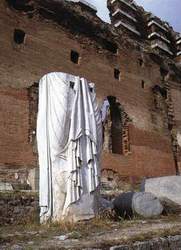
|
The Great Altar whose walls were decorated with reliefs showing the
bottle of Greek gods with the Giants also stood on the acropolis. Some scholars claim that
when St John referred to the Satan's throne he had the Great Altar in mind. St John was
probably concerned with the imperial cult more than the older Hellenistic cults, which had
begun to loosen their hold on the people. On the plain stood the famous sanctuary of
Asclepius, the temple of the healer-god, which attracted pilgrims and patients from
distant corners of the world. Other scholars believe that this referred to the mystical
chest (cyst) in which was kept a live serpent, a special object of veneration in the
Asclepion, or the sanctuary itself.
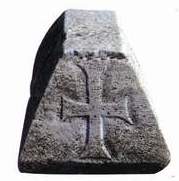
Marble capital from the Church of St
John the Theologian in the Red Court. Pergamum.
|
St John praises the Christians of Pergamum for not having given up their faith despite all
the pressure on them. Antipas, one of the spiritual leaders of the Pergamene congregation,
was martyred by being roasted in a brazen bull. In the New Testament the Greek word martyr
meaning witness' or testimony (In the course of time the word would gain its present day
meaning.) is used for bearing witness to the faith in Christ to the end of
one's life and used only twice meaning slain': at the stoning of St Stephen and here at
the martyrdom of Antipas.
It seems that despite their faith in the new religion,
some of the Christians in Pergamum were practicing the heresy of Balaam. The book of
Numbers (Nm 22-25 and 31:16) relates that after going out of Egypt, during their
wanderings to reach the Promised Land, the Israelites drew the Amorites out of their land
and set their camp near the land of the Moabites. The king of the latter, Balak, was
afraid that his people would suffer the fate of the Amorites and sent for the Old
Testament prophet Balaam to curse the Israelites. However, Balaam was unable to do so. In
the end, although it is not told how Balaam induced them, the people of Israel began
engaging in prostitution with Moabite women (The worship of the Semitic god Baal required
cultic prostitution.) and began to eat food sacrificed to gods by their neighbours (1 Kgs
16:31 and 2 Kgs 9:22, 30-37). |
In Pergamum
there are also those who believe in the teaching of the Nicolaitans, like their brothers
in Ephesus. After having acknowledged the problems in Pergamum, |
|
St John
admonishes those who waver to repent and threatens them that Christ will come for them
with the sword in his mouth - again referring to the impending Second Coming. The
believers who conquer - who have not eaten food sacrificed to idols - will be rewarded.
Their reward will be the hidden manna, the food that God gave the Israelites as
they wandered in the wilderness, in the sense that it will nourish their spirits forever.
Each member of the church is also to be given a white amulet, with a new name, a
name of glory.
Excavations have brought to light the remains of a number
of church buildings in ancient Pergamum. The best known of these is the Church of St John
that was built into the so-called Red Court. This was probably built in the fourth century
and served as the cathedral of the city.
Another church of the early period occupied the courtyard of the
lower agora but has no visible remains at present. |
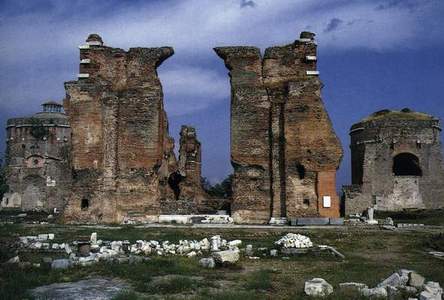
Outview of Serapys Temple
|
|
A third one occupied the site of the enclosure of the Temple of Athena on top of the
acropolis. This was built during the time of Justinian the Great and some of its marble
floor pavement still survives. The Christians who lived in the Asclepion district had
their own churches here. Achaeologists have also distinguished traces of other less
important church buildings among the ruins dating from the later Byzantine period. It is
assumed that in Pergamum as elsewhere, the Christian community included some Jewish
converts. Although a gable from a synagogue door or screen showing a menorah has been
discovered, the place where the synagogue was located is not known. |
|

